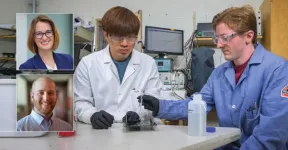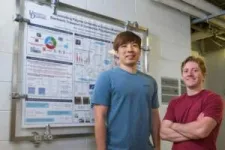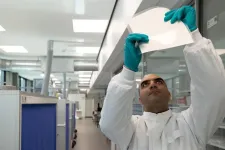(Press-News.org) University of Delaware and Argonne National Laboratory have come up with a chemical reaction that can convert Styrofoam into a high-value conducting polymer known as PEDOT:PSS. In a new paper published in JACS Au, the study demonstrates how upgraded plastic waste can be successfully incorporated into functional electronic devices, including silicon-based hybrid solar cells and organic electrochemical transistors.
The research group of corresponding author Laure Kayser, assistant professor in the Department of Materials Science and Engineering in UD’s College of Engineering with a joint appointment in the Department of Chemistry and Biochemistry in the College of Arts and Sciences, regularly works with PEDOT:PSS, a polymer that has both electronic and ionic conductivity, and was interested in finding ways to synthesize this material from plastic waste.
After connecting with Argonne chemist David Kaphan during an event hosted by UD’s research office, the research teams at UD and Argonne began evaluating the hypothesis that PEDOT:PSS could be made by sulfonating polystyrene, a synthetic plastic found in many types of disposable containers and packing materials.
Sulfonation is a common chemical reaction where a hydrogen atom is replaced by sulfonic acid; the process is used to create a variety of products such as dyes, drugs and ion exchange resins. These reactions can either be “hard“ (with higher conversion efficiency but that require caustic reagents) or “soft” (a less efficient method but one that uses milder materials).
In this paper, the researchers wanted to find something in the middle: "A reagent that is efficient enough to get really high degrees of functionalization but that doesn't mess up your polymer chain,” Kayser explained.
The researchers first turned to a method described in a previous study for sulfonating small molecules, one that showed promising results in terms of efficiency and yield, using 1,3-Disulfonic acid imidazolium chloride ([Dsim]Cl). But adding functional groups onto a polymer is more challenging than for a small molecule, the researchers explained, because not only are unwanted byproducts harder to separate, any small errors in the polymer chain can change its overall properties.
To address this challenge, the researchers embarked on many months of trial and error to find the optimal conditions that minimized side reactions, said Kelsey Koutsoukos, a materials science doctoral candidate and second author of this paper.
“We screened different organic solvents, different molar ratios of the sulfonating agent, and evaluated different temperatures and times to see which conditions were the best for achieving high degrees of sulfonation,” he said.
The researchers were able to find reaction conditions that resulted in high polymer sulfonation, minimal defects and high efficiency, all while using a mild sulfonating agent. And because the researchers were able to use polystyrene, specifically waste Styrofoam, as a starting material, their method also represents an efficient way to convert plastic waste into PEDOT:PSS.
Once the researchers had PEDOT:PSS in hand, they were able to compare how their waste-derived polymer performed compared to commercially available PEDOT:PSS.
“In this paper, we looked at two devices — an organic electronic transistor and a solar cell,” said Chun-Yuan Lo, a chemistry doctoral candidate and the paper’s first author. “The performance of both types of conductive polymers was comparable, and shows that our method is a very eco-friendly approach for converting polystyrene waste into high-value electronic materials.”
Specific analyses conducted at UD included X-ray photoelectron spectroscopy (XPS) at the surface analysis facility, film thickness analysis at the UD Nanofabrication Facility, and solar cell evaluation at the Institute of Energy Conversion. Argonne’s advanced spectroscopy equipment, such as carbon NMR, was used for detailed polymer characterization. Additional support was provided by materials science and engineering professor Robert Opila for solar cell analysis and by David C. Martin, the Karl W. and Renate Böer Chaired Professor of Materials Science and Engineering, for the electronic device performance analyses.
One unexpected finding related to the chemistry, the researchers added, is the ability to use stoichiometric ratios during the reaction.
“Typically, for sulfonation of polystyrene, you have to use an excess of really harsh reagents. Here, being able to use a stoichiometric ratio means that we can minimize the amount of waste being generated,” Koutsoukos said.
This finding is something the Kayser group will be looking into further as a way to “fine-tune” the degree of sulfonation. So far, they’ve found that by varying the ratio of starting materials, they can change the degree of sulfonation on the polymer. Along with studying how this degree of sulfonation impacts the electrical properties of PEDOT:PSS, the team is interested in seeing how this fine-tuning capability can be used for other applications, such as fuel cells or water filtration devices, where the degree of sulfonation greatly impacts a material’s properties.
“For the electronic devices community, the key takeaway is that you can make electronic materials from trash, and they perform just as well as what you would purchase commercially,” Kayser said. “For the more traditional polymer scientists, the fact that you can very efficiently and precisely control the degree of sulfonation is going to be of interest to a lot of different communities and applications.”
The researchers also see great potential for how this research can contribute to ongoing global sustainability efforts by providing a new way to convert waste products into value-added materials.
“Many scientists and researchers are working hard on upcycling and recycling efforts, either by chemical or mechanical means, and our study provides another example of how we can address this challenge,” Lo said.
The complete list of co-authors includes Chun-Yuan Lo, Kelsey Koutsoukos, Dan My Nguyen, Yuhang Wu, David Angel Trujillo, Tulaja Shrestha, Ethan Mackey, Vidhika Damani, Robert Opila, David Martin, and Laure Kayser from the University of Delaware and Tabitha Miller, Uddhav Kanbur, and David Kaphan from Argonne National Laboratory.
END
Plastic waste can now be converted to electronic devices
New study conducted from UD researcher and Argonne National Laboratory shows how waste Styrofoam can be transformed into polymers for electronics.
2024-07-19
ELSE PRESS RELEASES FROM THIS DATE:
Health equity scholar Darrell Hudson named Health Behavior and Health Education chair at the University of Michigan School of Public Health
2024-07-19
Leading health equity researcher Darrell Hudson, MPH ‘05, PhD ‘09, has been named chair of the Department of Health Behavior and Health Education at the University of Michigan School of Public Health. His appointment for a five-year term, effective August 26, 2024, was approved by the University of Michigan Board of Regents this week.
“Dr. Hudson has solidified his national reputation as a leading health equity scholar, making impactful research contributions through rigorous, interdisciplinary, and innovative scholarship,” said F. DuBois Bowman, dean of Michigan Public Health. “His research is timely ...
Research will establish best ‘managed retreat’ practices for communities faced with climate change disaster
2024-07-19
LAWRENCE — Around the globe, communities at risk from repeated flooding due to climate change face stark decisions. Some communities in peril of flooding may resolve, or be urged, to relocate to a safer location — something known as “managed retreat.” In the United States, flood-prone communities in coastal states like Louisiana and Alaska already have commenced managed retreat inland.
“It's retreating from risk, and we hope to provide decision support for the equitable implementation ...
Marshall University awarded grant to further fentanyl addiction research
2024-07-19
HUNTINGTON, W.Va. – Marshall University was awarded a $3.3 million grant (#R01DA057931) from the National Institute on Drug Abuse (NIDA) to examine the genetic mechanisms that underlie fentanyl addiction.
In 2022, fentanyl overdose was the leading cause of death for U.S. adults aged 18 to 45, according to Families Against Fentanyl (2023).
“This alarming statistic highlights the urgent need to understand why some people are more susceptible to fentanyl addiction,” ...
Wash U researchers shine light on amyloid architecture
2024-07-19
By Leah Shaffer
Amyloid-beta (A-beta) aggregates are tangles of proteins most notably associated with neurodegenerative diseases like Alzheimer’s. Despite its constant stint in the limelight, however, researchers have been unable to get a good understanding of how A-beta comes together and breaks apart.
“The way A-beta behaves in a variety of environments, including the human brain, is elusive,” said Brian Sun, an electrical systems and engineering alumnus of Washington University in St. Louis who is now an MD/PhD student in the School of Medicine.
“There’s an understanding of growth and decay that isn’t ...
New dawn for space storm alerts could help shield Earth's tech
2024-07-19
New dawn for space storm alerts could help shield Earth's tech
Royal Astronomical Society press release
RAS PR 24/22 (NAM 8)
For immediate release
Space storms could soon be forecasted with greater accuracy than ever before thanks to a big leap forward in our understanding of exactly when a violent solar eruption may hit Earth.
Scientists say it is now possible to predict the precise speed a coronal mass ejection (CME) is travelling at and when it will smash into our planet – even before it has fully erupted from ...
Tomorrow’s super battery for electric cars is made of rock
2024-07-19
In 10 years, solid-state batteries made from rock silicates will be an environmentally friendly, more efficient and safer alternative to the lithium-ion batteries we use today. Researcher at DTU have patented a new superionic material based on potassium silicate - a mineral that can be extracted from ordinary rocks.
It is the battery in your electric car that determines how far you can drive on one charge and how quickly you can re-charge. However, the lithium-ion battery, the most widely used electric car battery today, has its limitations— in terms of capacity, safety and also availability. ...
Fecal immunochemical test screening and risk of colorectal cancer death
2024-07-19
About The Study: In this nested case-control study, completing fecal immunochemical test was associated with a lower risk of overall death from colorectal cancer, particularly in the left colon, and the associations were observed across racial and ethnic groups. These findings support the use of fecal immunochemical test in population-based screening strategies.
Corresponding Author: To contact the corresponding author, Chyke A. Doubeni, M.D., M.P.H., email chyke.doubeni@osumc.edu.
To access the embargoed ...
Long-term use of oral corticosteroids and safety outcomes for patients with atopic dermatitis
2024-07-19
About The Study: Oral corticosteroid use of more than 90 days per year among individuals with atopic dermatitis was associated with a small increased risk of composite adverse outcomes in this large population-based case-control study. Future investigations are warranted to confirm this potential risk of adverse events (AEs) associated with long-term use of oral corticosteroids for patients with exacerbations of atopic dermatitis, and health care professionals should thoroughly weigh the benefits associated with oral corticosteroids ...
Diagnosing solid lesions in the pancreas with multimodal AI
2024-07-19
About The Study: In this randomized crossover trial of diagnosing solid lesions in the pancreas with or without artificial intelligence (AI) assistance, the joint-AI model demonstrated positive human-AI interaction, which suggested its potential to facilitate a clinical diagnosis. Nevertheless, future randomized clinical trials are warranted.
Corresponding Authors: To contact the corresponding authors, email Aiming Yang, M.D. (yangaiming@medmail.com.cn) and Bin Cheng, M.D. (b.cheng@tjh.tjmu.edu.cn).
To access the embargoed study: Visit our For The Media website at this link https://media.jamanetwork.com/
(doi:10.1001/jamanetworkopen.2024.22454)
Editor’s ...
Trillions lost in worker productivity due to eco anxiety and ‘lie-back’ lifestyles
2024-07-19
Could nature and climate anxieties predict future social behaviours, in the same way that consumer sentiment predicts purchasing and investment?
The suggestion is made in the Cell Press journal One Earth, by Griffith University’s Professor Emeritus Ralf Buckley, in a preview of an article led by Professor Thomas Pienkowski in the UK.
Professor Buckley said the international Global Burden of Disease Study had shown that anxiety and depression were widespread and worsening.
“Economic costs are up to 16% of global GDP, with 19 days per year on average lost ...
LAST 30 PRESS RELEASES:
Heart-brain connection: international study reveals the role of the vagus nerve in keeping the heart young
Researchers identify Rb1 as a predictive biomarker for a new therapeutic strategy in some breast cancers
Survey reveals ethical gaps slowing AI adoption in pediatric surgery
Stimulant ADHD medications work differently than thought
AI overestimates how smart people are, according to HSE economists
HSE researchers create genome-wide map of quadruplexes
Scientists boost cell "powerhouses" to burn more calories
Automatic label checking: The missing step in making reliable medical AI
Low daily alcohol intake linked to 50% heightened mouth cancer risk in India
American Meteorological Society announces Rick Spinrad as 2026 President-Elect
Biomass-based carbon capture spotlighted in newly released global climate webinar recording
Illuminating invisible nano pollutants: advanced bioimaging tracks the full journey of emerging nanoscale contaminants in living systems
How does age affect recovery from spinal cord injury?
Novel AI tool offers prognosis for patients with head and neck cancer
Fathers’ microplastic exposure tied to their children’s metabolic problems
Research validates laboratory model for studying high-grade serous ovarian cancer
SIR 2026 delivers transformative breakthroughs in minimally invasive medicine to improve patient care
Stem Cell Reports most downloaded papers of 2025 highlight the breadth and impact of stem cell research
Oxford-led study estimates NHS spends around 3% of its primary and secondary care budget on the health impacts of heat and cold in England
A researcher’s long quest leads to a smart composite breakthrough
Urban wild bees act as “microbial sensors” of city health.
New study finds where you live affects recovery after a hip fracture
Forecasting the impact of fully automated vehicle adoption on US road traffic injuries
Alcohol-related hospitalizations from 2016 to 2022
Semaglutide and hospitalizations in patients with obesity and established cardiovascular disease
Researchers ‘listen in’ to embryo-mother interactions during implantation using a culture system replicating the womb lining
How changing your diet could help save the world
How to make AI truly scalable and reliable for real-time traffic assignment?
Beyond fragmented markets: A new framework for efficient and stable ride-pooling
Can shape priors make road perception more reliable for autonomous driving?
[Press-News.org] Plastic waste can now be converted to electronic devicesNew study conducted from UD researcher and Argonne National Laboratory shows how waste Styrofoam can be transformed into polymers for electronics.





